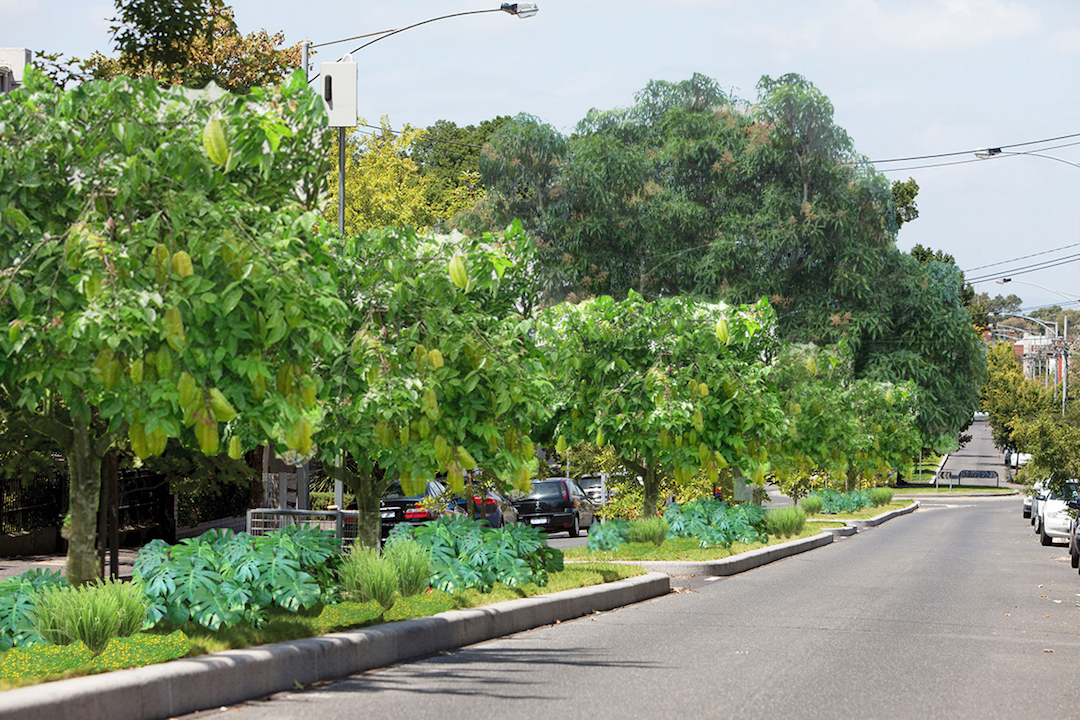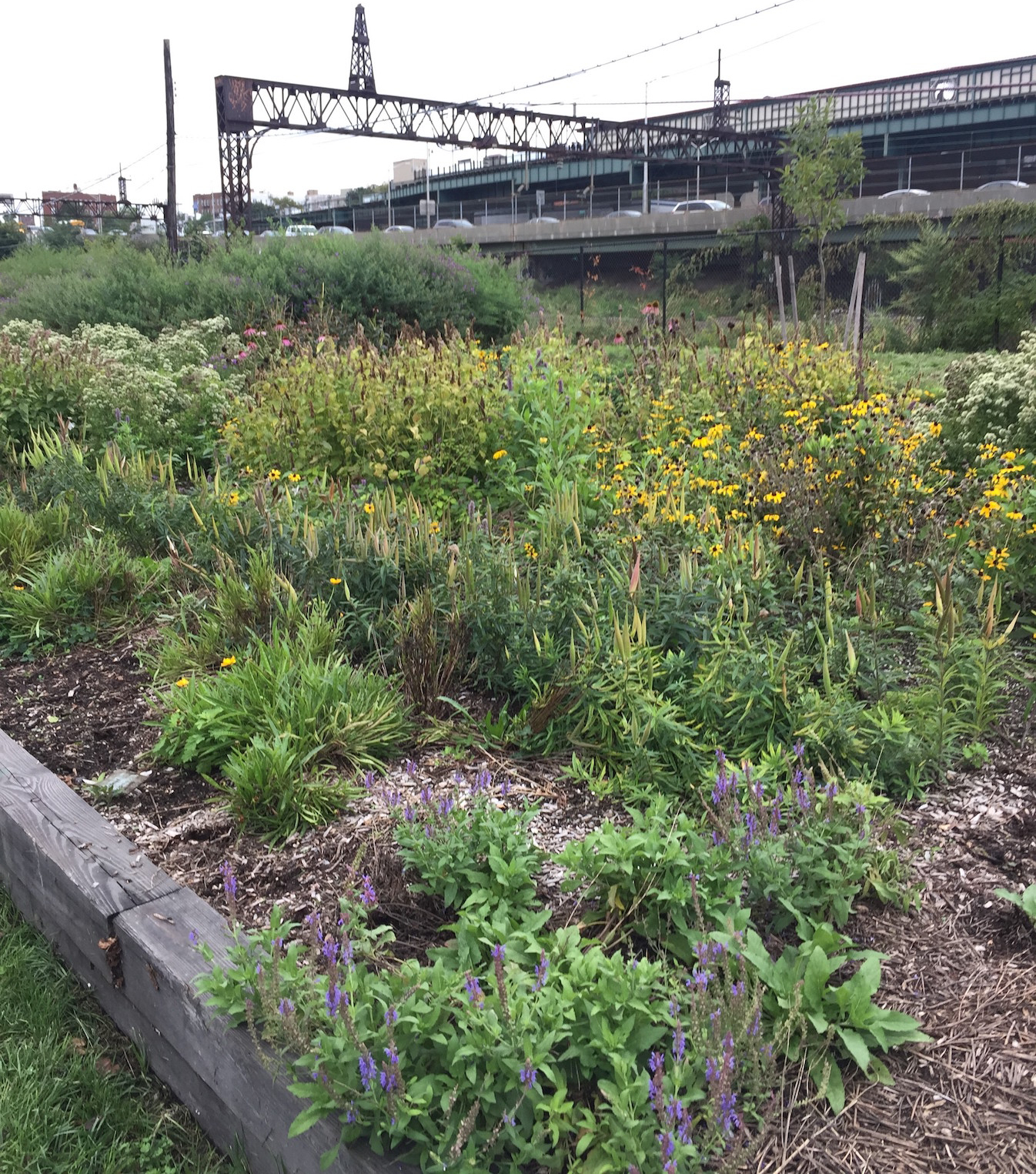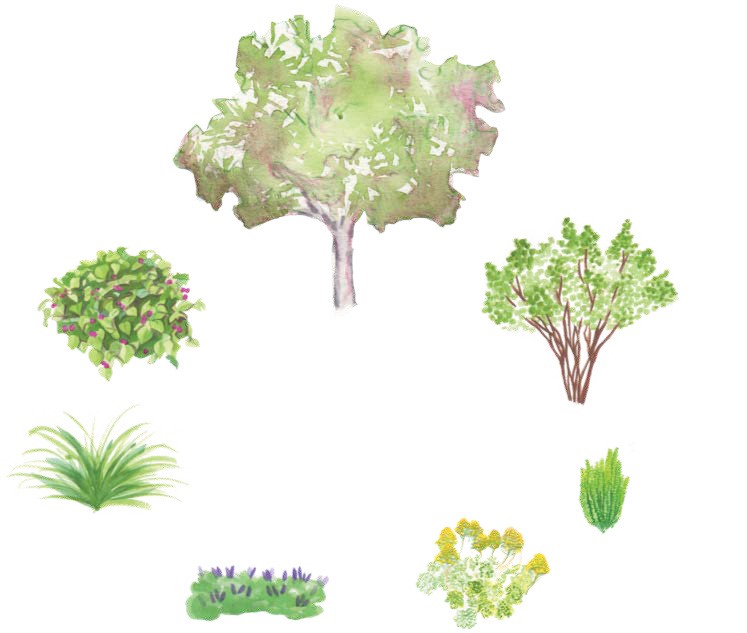Inhabit Earth’s (http://inhabit.earth) mission is global climate stabilization. There is emerging research that indicates that most agroforestry systems perform better than natural forests in sequestering carbon. This is well documented in seminal works such as The Carbon Farming Solution and Project Drawdown.
We have been applying innovative approaches that leverage urban forests to address complex ecosocial challenges and begin to stabilize climate. The innovation lies in integrating and extending various fields of practice, such as agroforestry, regional planning, urban agriculture, landscape architecture, permaculture, and economic development.
Urban Agroforestry
As one might imagine, practicing agroforestry in urban settings is not without its challenges. Yet, in most communities, there exists an overabundance of underutilized spaces, particularly in economically-challenged neighborhoods.
 Figure 1 Rendering of a tropical foodscape in a street median, featuring a starfruit canopy with an understory of lemongrass, monster, and perennial peanut (produced by Thais Thiesen)
Figure 1 Rendering of a tropical foodscape in a street median, featuring a starfruit canopy with an understory of lemongrass, monster, and perennial peanut (produced by Thais Thiesen)
FoodPlaces (http://foodplaces.org), an online open-source platform, came into being to make it simple, acceptable, and desirable for communities to grow food in underutilized public/civic spaces. Using FoodPlaces, practitioners can plan foodscapes – beautiful, functional, and productive landscapes using assemblies of plants that produce food, fuel, fiber, feed (forage/fodder), and/or “farmaceuticals” (plant-based medicines) (Figure 1).
Foodscapes are primarily composed of perennial plants chosen for the appropriateness in a particular context and because they provide multiple functions for each other in ways that mimic natural ecosystems. This lessens the need for human intervention while optimizing yields. To amplify their impact, foodscapes can be arranged into foodways – corridors of foodscapes and related community-operated spaces (Figure 2).
Foodscapes can form part of a larger strategy for cultivating resilient human communities – primary production – one that provides basic material needs for all regeneratively within a naturally-bounded geography, or bioregion, while growing circular economies and reducing carbon footprints.

Figure 2 Traffic along the expressway next to the Bronx Foodway, a project of Inhabit Earth, featured in Civil Eats (https://civileats.com/2019/01/01/the-bronx-city-park-that-is-part-of-a-wave-of-forage-friendly-public-lands/) (Photo by Danielle Beurteaux)
The Platform
FoodPlaces serves as a container for the Foodscape Assembler, a Plant Wiki and a Species Index. The Foodscape Assembler was designed and built with ease-of-use in mind. Anyone with a good grasp of the spatial context they are planning, can effortlessly walk through the template-driven process. Users can modify existing templates, or create new ones. These templates can be reflective of existing municipal codes or can be utilized to generate code. The Plant Wiki contains approximately 15,000 PDFs of productive plants from around the world. The wiki is organized by species and categorized by genera. Each entry has a basic description and one or more PDF files linked. It supports multiple file formats. The Species Index is a database of 500+ productive, perennial plants for North America. The index tracks the plant’s identity, structure, and behavior, its particular needs, the services it provides, and its yields. Collectively, the index’s values allow the system to generate a palette of elements to be used by the Assembler tool.
 Figure 3a Sampling of foodscape elements
Figure 3a Sampling of foodscape elements
Templates use elemental patterns (Figure 3a) – 42 plant patterns (trees, palms, shrubs, vines, graminoids, and forbs) used to build a foodscape (Figure 3b). The significance: users need not to be familiar with a great deal of species to create a productive landscape. A complex algorithm applies user settings for preferences and geographical location to generate a list of edible/useful plant species. The Assembler is linked to the Wiki and Index, enabling the user to access relevant data on any species suggested for consideration.

Figure 3b Example of a foodscape
Collective Impact
At Inhabit Earth, we strongly believe that if human societies wait for singular extraordinary efforts to bring about climate stabilization, we may never achieve it. With FoodPlaces, we have created a platform that facilitates small regenerative practices – a foodscape in a median or alongside a highway, for instance – to be distributed broadly and replicated easily by anyone anywhere. We are now focused on growing a community of practitioners who are eager to adopt/test these practices and share their experiences. Our intention is that FoodPlaces becomes a self-organizing ecosystem that continues to curate and document a growing body of regenerative practices whose cumulative effect will quickly add up and create an extraordinary collective impact.
References
Hawken, P (2017) Project drawdown: the most comprehensive plan ever proposed to reverse global warming. Penguin, New York
Toensmeier, E (2016) The carbon farming solution: a global toolkit of perennial crops and regenerative agriculture practices for climate change mitigation and food security. Chelsea Green Publishing, Vermont

